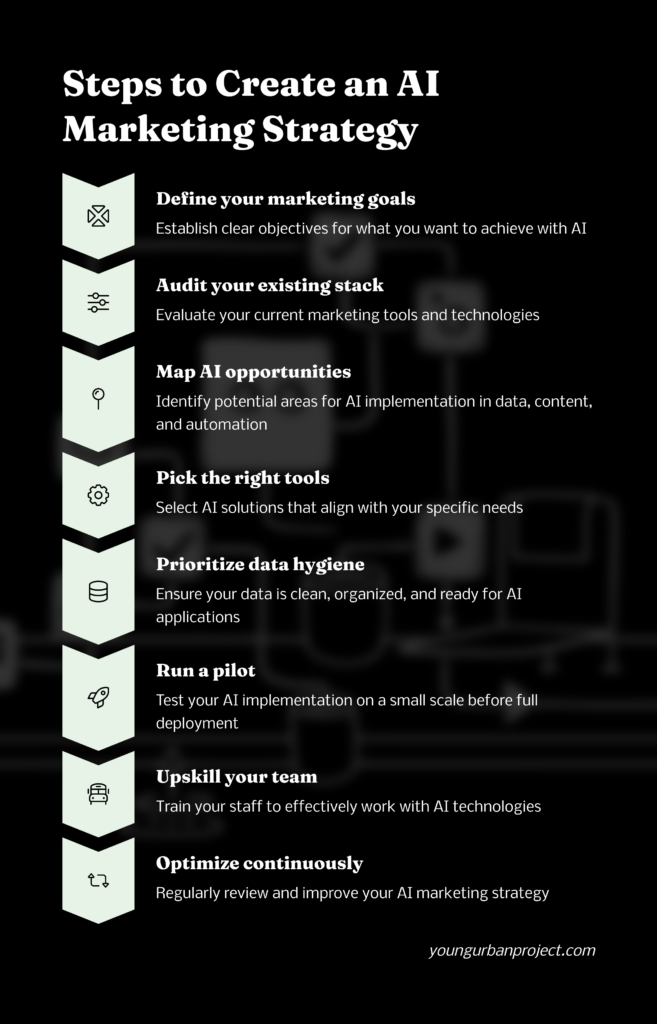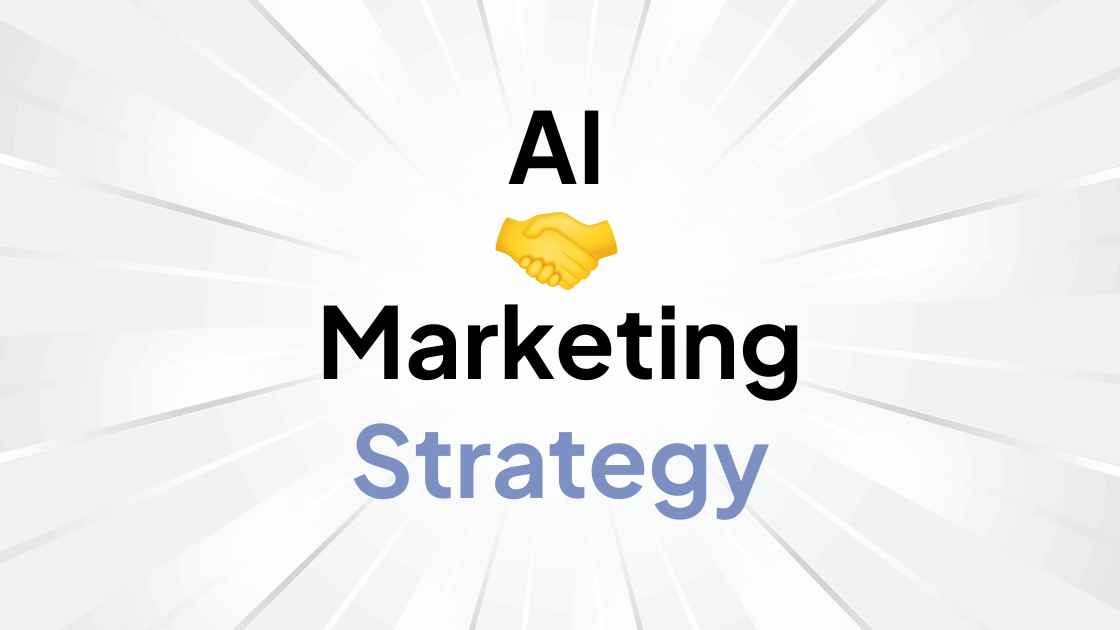Artificial Intelligence (AI) isn’t just a buzzword anymore. It’s woven into almost every digital touchpoint we have – from personalized Netflix suggestions to real-time chatbot support on e-commerce sites. If you’re a marketer or entrepreneur, learning how to build an AI marketing strategy isn’t just helpful… it’s essential.
But here’s the deal: creating a proper Generative AI-powered marketing strategy isn’t just about slapping “AI” onto your pitch deck. It’s about understanding where automation, data, and machine learning can create actual, measurable value.
In this guide, we’ll break down exactly how to do that, step-by-step. Whether you’re a solo founder, a marketer at a startup, or part of a bigger brand team, this blueprint will help you start strong.
Table of Contents
Why You Need an AI Marketing Strategy Today
Let’s be real – marketing is getting harder. Consumers are savvier, channels are noisier, and attention spans? Practically non-existent. AI can help you:
- Personalize content at scale
- Predict consumer behavior
- Automate repetitive tasks
- Optimize media spend
- Generate high-performing creatives (yes, even copy!)
Companies like Netflix, Amazon, Sephora, and even local D2C brands in India like Lenskart, Cred, Young Urban Project are already using AI to crush it.
So let’s get into the nitty-gritty of actually creating your AI marketing strategy.
TL;DR: Steps to Create an AI Marketing Strategy
- Define your marketing goals
- Audit your existing stack
- Map AI opportunities (data, content, automation)
- Pick the right tools
- Prioritize data hygiene
- Run a pilot
- Upskill your team
- Optimize continuously
How to Build Your AI-Marketing Strategy Step-by-Step

Step 1: Define Your Business Goals
Before you touch a single tool or prompt, step back.
Ask yourself:
- What do I want AI to help me achieve?
- Do I want to improve lead generation?
- Am I trying to reduce churn?
- Is my focus on content creation or media buying?
Tie your AI marketing strategy to specific, measurable business objectives. This could look like:
- Increase lead conversion rates by 20% using AI-driven personalization
- Reduce ad spend waste by 30% via predictive targeting models
- Automate 60% of blog content production using AI writing tools
The clearer the goal, the easier it is to choose the right tools and track ROI.
Step 2: Audit Your Current Marketing Ecosystem
Before adding AI into the mix, you need to understand your current setup. Start by answering:
- What platforms and tools are you already using? (CRM, email marketing, analytics, etc.)
- Where are the bottlenecks?
- Which tasks take the most manual effort?
- Where are you leaking time or money?
This will help you identify where AI can plug in without breaking your workflow.
Example: If your team spends 10 hours/week writing social captions, AI copywriting tools like Jasper, Copy.ai or ChatGPT can save time.
Or if your Google Ads performance is stagnating, AI tools like AdCreative.ai or Smartly.io might give you a lift.
Also Read: AI in Digital Marketing
Step 3: Segment AI Opportunities
Now, categorize your potential AI use-cases. Think across three main buckets:
1. Data & Insights
- Predictive analytics
- Customer segmentation
- Trend detection
- Sentiment analysis
2. Content & Creatives
- AI-generated copy (ChatGPT, Copy.ai)
- AI video tools (Sora, Kling.ai, RunwayML)
- Ad creative automation (AdCreative.ai)
- Email subject line optimization
3. Automation & Execution
- Chatbots (ManyChat, Interakt, Wati)
- Email drip workflows (Brevo, ActiveCampaign, Mailmodo)
- Media buying automation (Meta Advantage+, Performance Max)
Prioritize these based on effort vs. impact. Start small, scale what works.
Step 4: Choose the Right AI Tools
Now comes the fun part. But also: don’t go tool-crazy.
Here are some categories to explore:
AI tools for Content:
- ChatGPT / Claude for ideation and writing
- Copy.ai for short-form ad content
- SurferSEO for AI + SEO-optimized blogs
- Canva + Magic Write for social content
AI for Media:
- AdCreative.ai for banners and ad designs
- Smartly.io for media buying
- Performance Max for Google Ads automation
AI for Analytics:
- PaveAI (turns Google Analytics into insights)
- Crystal Knows (personality-based targeting)
- HubSpot AI for CRM insights
Make sure whatever you pick integrates well with your tech stack.
Step 5: Data Is Your Fuel
AI is only as good as the data it feeds on. So:
- Clean up your CRM or customer database
- Ensure accurate tracking across platforms (use UTM, GA4, etc.)
- Collect first-party data through lead forms, quizzes, and chatbots
- Respect privacy (very important in 2025 with stricter data laws)
Tip: Build feedback loops. Use AI to test something, then collect results, and re-feed into the model.
Step 6: Build a Pilot Program
Don’t try to AI-everything on day one. Choose one campaign or channel to test AI.
Example Pilot:
- Objective: Increase email open rates
- Tool: ChatGPT + Mailmodo AI Subject Line Tester
- Method: A/B test AI-written vs. human-written lines
- Timeline: 30 days
Track performance. Learn fast. Adjust.
Once you have proof of concept, expand slowly.
Step 7: Train Your Team (or Yourself)
AI tools don’t replace marketers. They enhance them.
Make sure your team knows:
- How to prompt effectively
- How to validate AI outputs (very important)
- How to collaborate with AI
Consider enrolling your team in AI-marketing workshops (like the ones we run at Young Urban Project).
Because here’s the truth: a mediocre marketer with AI beats a great marketer without it.
Step 8: Track and Optimize
AI doesn’t mean “set it and forget it.”
Track key metrics like:
- Conversion Rate
- Cost per Acquisition (CPA)
- Engagement Rate
- Time Saved per Task
Use tools like Google Looker Studio or Dashthis to build dashboards. This will help you justify future AI investments to leadership.
Also – test, iterate, repeat. Just like with any marketing channel.
Avoid these AI Marketing Strategy Mistakes
- Too many tools, not enough use: Start lean. Get ROI before scaling.
- No clear goals: AI isn’t magic. It needs direction.
- Ignoring the human touch: Over-automation kills brand voice.
- Not training staff: The tool is only as good as the person using it.
AI Strategy Examples Across Industries
Let’s be honest — no one-size-fits-all strategy exists when it comes to AI in marketing. The impact (and implementation) of AI depends heavily on your industry.
Here are some tailored examples to spark ideas:
🛒 E-commerce (D2C & Retail)
- Product Recommendations: Tools like Vue.ai and Adobe Sensei power real-time personalized product suggestions based on browsing history and behavior.
- Smart Search: AI-powered search bars (like Klevu or Algolia) help customers find exactly what they’re looking for — faster.
- Abandoned Cart Automation: Predictive email flows recover sales with AI-driven copy and send-time optimization.
💻 SaaS & Tech
- Lead Scoring: AI models score leads based on behavioral signals, helping sales teams prioritize hot prospects.
- Onboarding Journeys: Tools like Intercom use AI to customize user onboarding flows, reducing churn.
- Churn Prediction: Platforms like Gainsight or Baremetrics use AI to forecast and flag accounts at risk.
🏢 Real Estate & Property Tech
- AI Chatbots: Handle 24/7 inquiries, schedule visits, and qualify leads instantly (hello, time-saved).
- Visual Recognition: AI tools like Restb.ai can tag listing photos, improving search and UX.
- Predictive Nurturing: Analyze buyer behavior to suggest relevant properties via email or WhatsApp.
🎓 EdTech & Online Learning
- Personalized Learning Paths: AI curates course modules based on learner progress.
- Content Creation: Automate quiz generation, summaries, or video scripts.
- AI Tutors: Tools like Scribe or Khanmigo enhance student support at scale.
These examples prove one thing: AI isn’t just for tech giants. It’s shaping marketing across the board.
Want to master Advanced AI for Marketing? Want to use top AI tools in your workflow, and build AI Agents? 👇

Final Thoughts: Start Small, Think Big
Creating an AI marketing strategy can feel overwhelming. But you don’t need to go all in overnight. Start with one use-case. Track results. Build from there.
AI isn’t here to take your job. It’s here to take your repetitive tasks, so you can focus on the strategic, creative stuff that truly moves the needle.
The future of marketing isn’t AI vs. humans. It’s AI with humans. The sooner you align your strategy to that reality, the faster you’ll grow.

